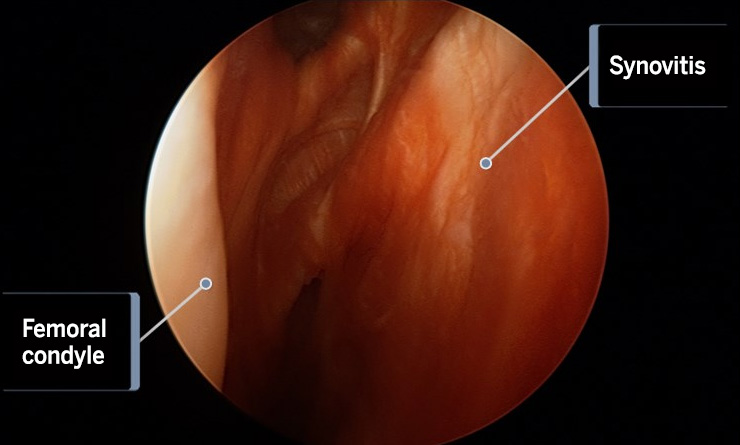Synovitis
Synovial joints, such as the hip and knee, have a sheath of tissue known as a joint capsule that contains a synovium. This membrane produces a special fluid to lubricate the joint and prevent wear on cartilage while the joint is in motion. Injuries, osteoarthritis and various types of inflammatory arthritis can cause swelling of the synovium, which can lead to pain and other symptoms.
What is synovitis?
Synovitis (or synovial inflammation) is when the synovium of a joint becomes inflamed (swollen). The synovium, which is also sometimes called the stratum synoviale or synovial stratum, is connective tissue that lines the inside of the joint capsule.
A joint capsule, also called an articular capsule, is a bubble-like structure that surrounds joints such as the shoulder, elbow, wrist, hand, knee, foot and ankle. It is composed of a tough, outer layer called the fibrous stratum and a soft inside layer (the synovium). Contained inside both layers is synovial fluid, a viscous liquid that lubricates the joint to reduce friction on the articular cartilage during motion.
Synovitis causes
In an active, healthy person, the most common cause of synovitis is overuse of the joint, for example in athletes or people whose jobs involve repetitive stress movement such as lifting or squatting.
However, synovitis is also common in people who have some form of inflammatory arthritis. In these patients, excessive growth of the synovium is part of an abnormal immune response, where the body misidentifies its own natural cartilage as a foreign substance that must be attacked.
Cartilage loss eventually damages the joint surface and leads to the stiffness and pain characteristic of all types of arthritis. (Osteoarthritis, the more common form of the arthritis, does not involve this type of inflammatory response.)

Arthroscopic camera view of the inside of a knee joint, showing synovitis next to the femoral condyle (upper portion of the femur or thighbone). Image courtesy of Understand.com, LLC.
Synovitis symptoms
The chief symptom is arthralgia, which is Greek for “joint pain.” The pain of synovitis is usually more severe than expected based on the appearance of the joint. In other words, there may be no visible evidence of injury or swelling that is causing pain.
The symptoms are often short-lived and may be felt in different parts of the body at different times. However, when synovitis is caused by overuse of a joint, the pain usually remains in one spot.
Diagnosing synovitis
A rheumatologist will aim to diagnose the cause of the patient’s pain by first determining whether it is inside the joint itself, meaning true synovitis, or if it is actually caused by an inflammation of the tendons, referred to as tendonitis (sometimes spelled tendinitis). Imaging, such as an MRI or musculoskeletal ultrasound is often required to make a firm diagnosis. This imaging can also help determine what particular grade of synovitis a person has.
Synovitis treatments
Treatment for synovitis usually consists of rest and anti-inflammatory medications. Medications may include oral drugs known as DMARDs (disease-modifying antirheumatic drugs) and, in some cases, steroid injections. Patients who don’t respond to these treatments may be referred to an orthopedic surgeon to discuss a synovectomy, a procedure in which much of the synovium is removed. Learn more about synovitis treatments and related conditions from the articles listed below.
Synovitis treatment articles and videos
Conditions and issues related to synovitis
Synovitis Success Stories
In the news
